EXECUTIVE SUMMARY
The Southeast Asia Climate Outlook Survey 2021 has provided novel data on professional positions on reducing coal reliance, enduring short economic pain, and investing in renewables. These observations, some of which debunk myths on the issues, include the following:
- Young people lose their enthusiasm for climate advocacy and rapid energy transition as they mature.
- Consumers of social media are not significantly less supportive of rapid energy transition than those who use traditional sources (i.e., newspapers, radio, and television).
- Professionals from the business and academic sectors are more likely to hang onto coal for longer and avoid short-term economic pain from severing reliance on fossil fuels.
- More advanced economies in Southeast Asia are not necessarily more accepting of a rapid energy transition.
- Southeast Asian professionals who look up to Japan as a climate leader are less likely to support early diversion from coal.
INTRODUCTION
Energy security has been a controversial issue in Southeast Asia, at the heart of which lie the questions of how fast and by how much developing economies should divert from fossil fuels.
Some are adamant that developing countries have every right to keep burning fossil fuels, including the dirtiest coal; and the economic train should not slow down for the green crusades of the developed nations. Others know that an energy transition is inevitable as the price of solar energy generation drops and the prospect of coal-fired power plants becoming stranded assets increases.
EXPLAINING ENERGY TRANSITION
At this crossroad, we remain clueless about the extent of Southeast Asians’ support for the diversion from fossil fuels and the adoption of renewables. The Southeast Asian Climate Outlook Survey 2021 (Seah, Martinus, and Qiu 2021) recently asked 463 professionals from the public, private, academic, civil society and media sectors to find out.[1] The analysis specifically examines attitudes towards the following three positions on energy transition:
- ASEAN countries should cut their reliance on coal as soon as possible.
- Reduction of dependence on fossil fuels will be painful in the short term but beneficial to ASEAN economies in the long run.
- There is potential for ASEAN to tap into the renewable energy sector.
Cutting coal reliance
Southeast Asia has a difficult relationship with coal. The Philippines and Malaysia bit the bullet and declared a moratorium on coal, while Thailand and Vietnam on the other hand took the middle approach of embracing all energy sources – building renewable energy infrastructure faster than other Southeast Asian countries while keeping their coal capacity. Indonesia is holding on to its coal energy and coal exporting industry tightly.
China has cancelled several coal-fired plants in Vietnam and Indonesia and pledged no more new builds in Belt and Road signatories. Japan offers clean coal technology[2] to ASEAN as a strategy for cutting emissions. In the past decade, coal consumption in Indonesia and The Philippines has more than doubled. It is almost four times in Vietnam, while the reduction in Thailand is less than 12% (IEA 2020). There is certainly a shift in attitude this year as fewer new coal-fired power plants are being funded in these fast-growing and energy-hungry nations (Board 2021).
Long-term economic gain
Towards the end of the last century, Southeast Asia was blessed by an abundance of fossil fuel. The mining and exporting of oil and gas has brought wealth to countries like Malaysia and Brunei. However, as the international energy market moves toward diversification of energy sources and diversion from fossil fuel, Southeast Asia may sink into an economic dilemma. Do we continue to pursue the carbon-heavy energy path because we do not want the short-term economic pain? Or do we endure the short pain, divert from fossil fuel, and reap the long-term gain?
Investment in renewables
Strong sun and wind resources make Southeast Asia particularly suitable for developing renewable energy capability. Despite strong support from the governments, 70% of the energy market still relies on fossil fuels while the other 30% are renewables such as biomass and hydropower. From a very low base, the renewables have grown rapidly and solar may soon dominate the market (Khuong, McKenna, and Fichtner 2019).
Thailand spearheaded policies for implementing renewable energy infrastructure, but weak institutions and politicized regulation have brought the whole ambition to its knees (Sirasoontorn and Koomsup 2018). Targets were not achieved and projects abandoned. A more encouraging case is Vietnam, which has pulled almost every policy lever for scaling up its renewable capability (Thang and Burke 2021).
As rich as the context on policy milestones may be, we need to understand who the laggards of energy transition are. Based on the Southeast Asia Climate Outlook Survey 2021, the following analysis assesses the truthfulness of five beliefs in relation to youths, social media users, professionals, advanced economies, and climate leaders.
BELIEF 1: YOUTHS ARE MORE SUPPORTIVE OF RAPID ENERGY TRANSITION.
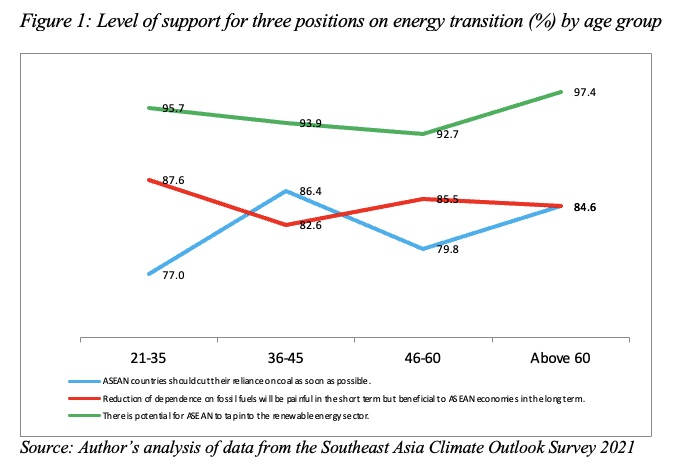
Whenever the policy community is frustrated by the incremental progress of climate action, it is not unusual that hope will be placed on the younger generation. The belief is that the young are more educated about climate change and not tied to the old ways of powering the economy. They also come with a level of moral legitimacy in the face of systemic inactions (Han and Ahn 2020). Their communication is not limited to the Armageddon narrative or the intractable political process, and measured solutions were proposed (Zummo, Gargroetzi, and Garcia 2020). However, younger professionals (aged 21-35) who took part in the survey were not starkly more pro-environment than their older counterparts. In the Survey, younger professionals are almost as likely to demonstrate pro-environment attitude towards transformational energy transition as the older professionals, especially those from the 36-45 and 46-60 age groups. Younger professionals were more enthused about reducing fossil fuel dependence for long-term economic interests and leveraging the potential of renewables. The surprise is that the younger professionals were less supportive of cutting coal reliance as soon as possible. By contrast, professionals over 60 years old are especially accepting of cutting coal and investing in renewables.
The younger professionals may have a more realistic sense of economic transition. They are less radical about ditching coal, which is the dominant energy source in the region. Almost all the younger professionals who did not agree with the statement on cutting coal were unsure rather than in disagreement. The hesitancy needs to be addressed firstly, through research studies that demonstrate that the divergence from coal will not fundamentally hurt Southeast Asian economies, and secondly, through strategic communication with young professionals of this. The popular belief that young people are more supportive of climate actions is only true among the pre-adolescents aged 7-13. Despite being more scientifically equipped to understand climate issues, 14-18 year old youths are less likely to support climate actions (Lee et al. 2020). This downward trend may extend into the 21- to 35-year-old professionals.
BELIEF 2: SOCIAL MEDIA USERS ARE LESS SUPPORTIVE OF RAPID ENERGY TRANSITION.
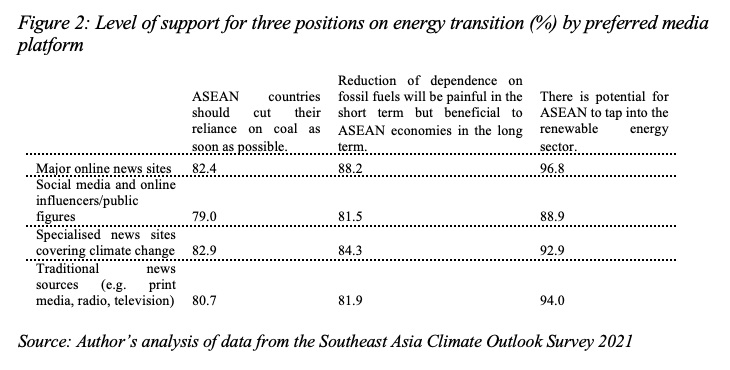
Professionals who rely on social media are less likely to support positions for cutting coal reliance, enduring short-term pain, and tapping into renewables. Another common belief is that users of media platforms managed by journalists and climate experts are more pro-environment. Conversely, social media has been criticized for offering a mixed bag of simplified messages, fake news and light entertainment. Climate-related topics are predominantly framed in negative ways on social media platforms, especially on Twitter (Dahal, Kumar, and Li 2019). Without professional curation, social media users have to differentiate evidence-based claims from untrustworthy information. The analysis in Figure 2 confirms this belief. However, the differences between users of social media and traditional news are not large for the first two positions on energy transition.
Youths in Southeast Asia have found social media to be an alternative space for acquiring and expressing diverse opinions while respecting the predominantly conservative and collectivistic societies in the region (Yue, Nekmat, and Beta 2019). For all ages, social media provides a mechanism for sharing information, generating discussion, and mobilising actions (Tandoc and Eng 2017). Media consumers use multiple sources that complement each other, especially on energy issues as controversial as the use of nuclear power in Southeast Asia (Ho et al. 2019).
BELIEF 3: PROFESSIONALS FROM DIFFERENT FIELDS SHOW SIMILAR SUPPORT FOR RAPID ENERGY TRANSITION.
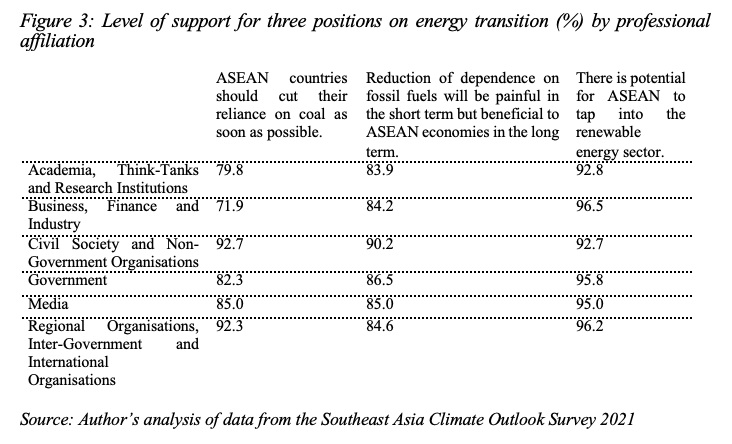
Professionals are assumed to be more highly educated and therefore more exposed to and receptive of scientific knowledge. The common understanding of climate change and energy transition should be shared among professionals from any field. It is unsurprising to see that the most climate-progressive professional group is civil society. At least 90% of the civil society respondents indicated their support for the three positions on energy transition. Different professional groups showed fairly similar levels of support for the positions on renewables and short-term pain but not on cutting coal reliance. It is important to acknowledge that all the professionals in this analysis did not deny the relevance of climate change in their work. However, professionals from the business sector are the least likely to support tough decisions on cutting coal even though they felt that it would be good for the economy in the long term. It is somewhat disconcerting to see that academics and researchers have not been more enthusiastic about cutting coal and reaping the long-term economic gains than the government and media professionals.
BELIEF 4: MORE ADVANCED ECONOMIES ARE MORE READY FOR ENERGY TRANSITION
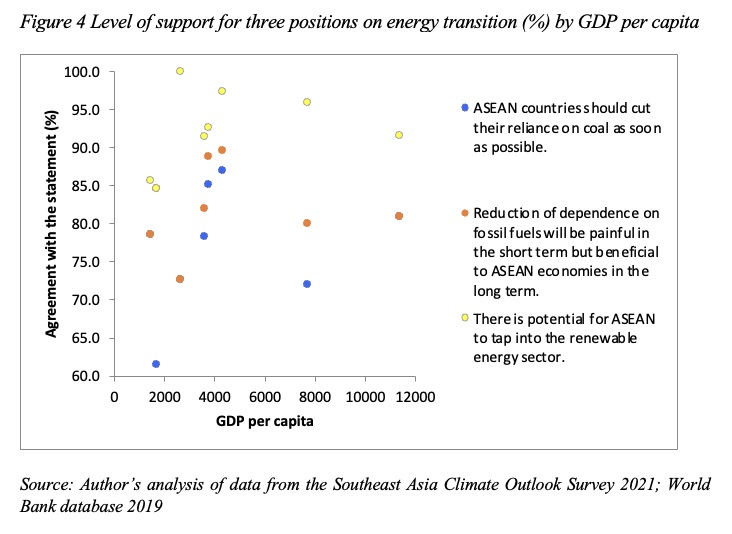
The presumption is that more economically advanced countries are more ready for energy transition. The analysis here shows that this linear relationship does not apply to countries with a relatively higher GDP per capita, which are Thailand, Malaysia, Brunei Darussalam and Singapore. The Kurznet curve could partially explain that individual countries will need to achieve sufficient economic success before they start considering environmental issues such as pollution and waste management. For example, Vietnam is two times wealthier than Cambodia. The Vietnamese respondents have greater desires to cut coal reliance, accept that diversion from fossil fuel is economically sensible, and embrace renewable energy. However, as Vietnam and Indonesia grow more, they may not enjoy proportionately greater support on issues related to fossil fuels. They would hit a pro-environment ceiling. In fact, they are already much more optimistic about energy transition than their richer neighbours – Thailand, Malaysia and Brunei Darussalam. This is perhaps less surprising for the last two countries that run its economy on oil. Thailand on the other hand is a disappointment. Only 72% of the Thai professionals felt that cutting coal soon is necessary. And 80% indicated that moving away from fossil fuel is largely good for the economy long-term. Were the Thai professionals more pessimistic or perhaps realistic about the impact of energy transition? Given the high support for renewable energy development, it is also possible that the Thai professionals held a preference for exploiting every type of energy sources to maximise energy security.
BELIEF 5 : CLIMATE LEADERS WILL LEAD BY EXAMPLE.
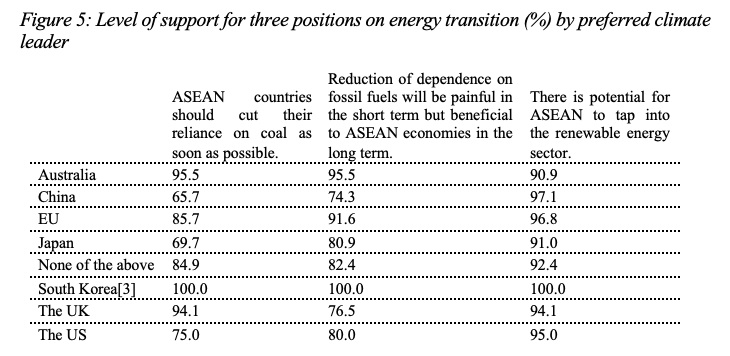
Climate leadership can be demonstrated by countries in various ways. Countries could be good at international negotiations of climate treaties and their absence in later summits would be palpable (Parker and Karlsson 2018). They may be critical in setting up the international institutions necessary for these negotiations to take place (Kopra 2020), and may lead by example when committing to ambitious climate goals and targets, which could be made easier if the process were primarily state-led and top down (Engels 2018). They can provide climate finance and support the development of appropriately ambitious climate policies in developing countries (Torney 2019). Southeast Asian countries should in theory be more influenced by their immediate neighbours (Glasgow, Zhao, and Rai 2021) in the Asia Pacific such as China, Australia, Japan and South Korea than other climate leaders such as the EU, UK and US. Beyond the states, similarly important is the climate leadership of some corporations that have thrived under supportive regulatory frameworks (Dupuis and Schweizer 2019).
It is unsurprising that professionals saw Japan and the EU as primary climate leaders. What is less known is whether the professionals who have confidence towards their preferred climate leaders are more likely to support rapid energy transition in their region. The Survey shows that supporters of climate leadership from China and Japan are less likely to buy into the need for cutting coal reliance as soon as possible. Only subscribers of EU leadership are enthusiastic about diverting from fossil fuel as a long-term economic strategy. The supporters of US leadership are not particularly keen on cutting coal and thinking long term, and the reverse is true for supporters of the Australian leadership. This contradicts with a track record of severe climate inaction from the Australian government.
FUTURE RESEARCH
This analysis about laggards of energy transition is far from conclusive. More research is needed to understand ways of sustaining climate advocacy as the younger generation matures. It remains a puzzle if users of social media and traditional news are open to diversifying their sources of information on climate change.
The relatively lower support for rapid energy transition from the business and academic sectors warrants reflection on whether the effort in persuading them is better spent somewhere else.
It is also critical to identify the factors that drive effective climate leadership, as national wealth, economic power and geographical proximity do not seem to consistently matter.
By Ryan Wong / ISEAS
The views and opinions expressed in this article are solely those of the author and do not necessarily reflect the position of AsiaWE Review.



